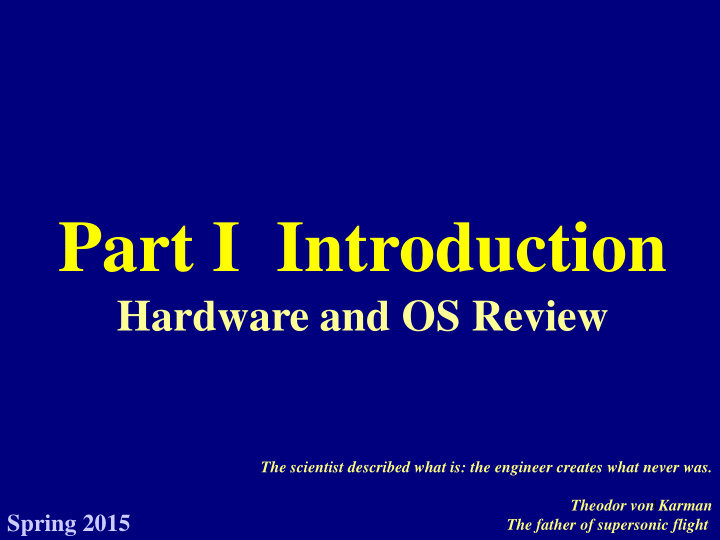



Part I Introduction Hardware and OS Review The scientist described what is: the engineer creates what never was. Theodor von Karman 1 Spring 2015 The father of supersonic flight
Mu Multipro proce cesso ssor r Sys System ems Multiprocessor systems, aka parallel systems or tightly coupled systems, have more than one CPUs. Adv dvan anta tage ges : Increased throughput: gets more jobs done Economy of scale: Because of resource sharing, multiprocessor systems are cheaper than multiple single processor systems. Increased reliability: the failure of one processor will not halt the whole system. 2
Sym Symme metri ric c Mu Multipr proc oces essi sing ng (SM SMP) P) Each processor performs all tasks under the control of the same OS. All processors are peers; no special (e.g., master-slave) relationship exists. CPU 2 CPU 0 CPU 1 registers registers registers cache cache cache 3 memory
Multico Mu core re CP CPUs Us This is multiprocessor on a single chip. They are more efficient since communications among cores are faster than among CPUs. They also consume less power. CPU core 0 CPU core 1 registers registers cache cache memory 4
Dual Dual-Mo Mode de Op Oper erat ation on Modern CPUs have two execution modes: the user mode and the supervisor (or system, kernel, privileged) mode, controlled by a mode bit. The he OS OS r run uns s in th n the e su supe perv rviso sor r mod ode e and an d al all us user er pr prog ogra rams s ru run n in n th the e us user er mod ode . Some instructions that may do harm to the OS (e.g., I/O and CPU mode change) are privileged instructions . Privileged instructions, for most cases, can only be used in the supervisor model. When execution switches to the OS (resp., a user program), execution mode is changed to the supervisor (resp., user) mode. 5
Special cial Ma Machine ine Inst structions ructions Ato tomic : These instructions execute as one uninterruptible unit. More precisely, when such an instruction is run, all other instructions being executed in various stages by the CPUs will be stopped (and perhaps re-issued later) until this instruction finishes. If two such instructions are issued at the same time, even though on different CPUs or cores, they will be executed sequentially. Pri rivi vileg eged ed : These instructions are, in general, privileged, meaning they can only execute in the supervisor or kernel mode. 6
Int nter erru rupt pt an and d Tr Trap ap An event that requires the attention of the OS is an int nter erru rupt pt . These events include the completion of an I/O, a keypress, a request for service, a division by zero and so on. Interrupts may be generated by hardware or software. An interrupt generated by software ( i.e ., division by 0) is usually referred to as a trap . Modern operating systems are interrupt driven , meaning the OS is in action only if an interrupt occurs. 7
Wh What at Is In s Inter errup upt-Driv Driven en? The OS is kernel activated by an interrupt interrupt. service The executing handler interrupt program is kernel mode suspended. mode switch Control is transferred to the user mode OS. A program will be ADD #4, 3 resumed when the service completes. 8
Sy Syst stem em Ca Calls System calls provide an interface to the services made available by an operating system. A system call generates an interrupt (actually a trap), and the caller is suspended. Type of system calls: Process control (e.g., create and destroy processes) File management (e.g., open and close files) Device management (e.g., read and write operations) Information maintenance (e.g., get time or date) Communication (e.g., send and receive messages) 9
Sy Syst stem em Ca Call Me Mech chan anism sm: 1/ 1/2 register X syscall 10 syscall service routine parameters a trap load addr. X syscall 10 10
Sys System em Ca Call Me Mech chan anism sm: 2/ 2/2 kernel A system call generates an interrupt, actually a interrupt syscall trap . handler services The executing program kernel mode (i.e., caller) is suspended. mode switch Control is transferred to user mode the OS. A program will be syscall 10 resumed when the system call service completes. 11
Ti Timer er Because the operating system must maintain the control over the CPU, it has to prevent a user program from getting the CPU forever without calling for system service (i.e., I/O). Use se an an int nter erva val t timer er ! An interval timer is a count-down timer. Before a user program runs, the OS sets the interval timer to certain value. Once the interval timer counts down to 0, an interrupt is generated and the OS can take appropriate action. 12
The End 13
Recommend
More recommend